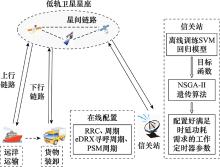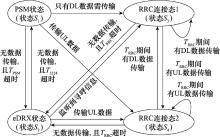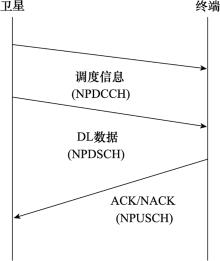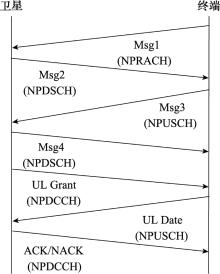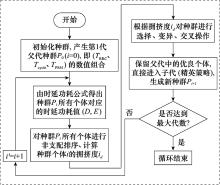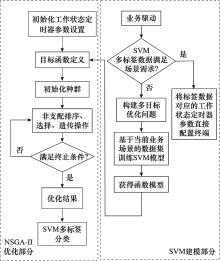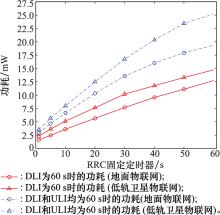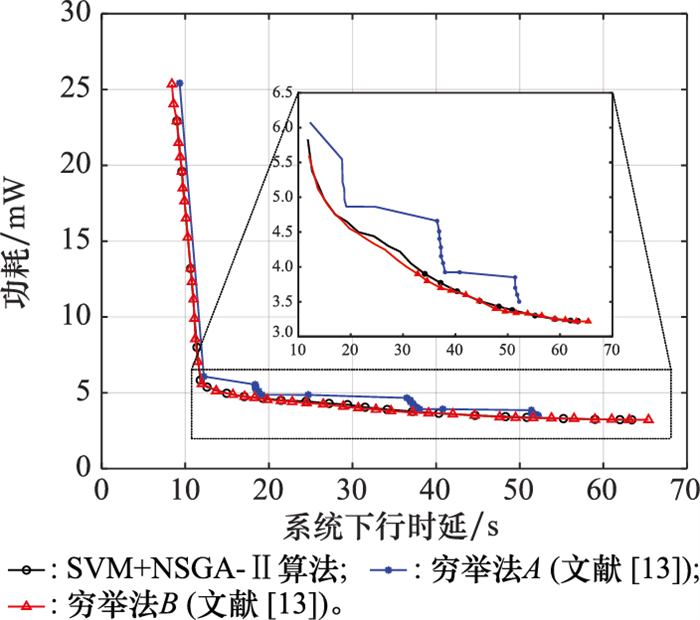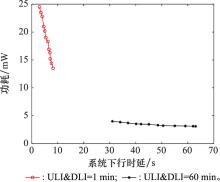Systems Engineering and Electronics ›› 2024, Vol. 46 ›› Issue (8): 2867-2876.doi: 10.12305/j.issn.1001-506X.2024.08.34
• Communications and Networks • Previous Articles
Business-driven terminal mode switching method for low Earth orbit satellite-based Internet of Things
Tao HONG, Fan WANG, Zhi LI, Zhiwei ZHONG, Xiaojin DING, Ziwei LIU, Gengxin ZHANG
- School of Communication and Information Engineering, Nanjing University of Posts and Telecommunications, Nanjing 210003, China
-
Received:2023-05-05Online:2024-07-25Published:2024-08-07 -
Contact:Tao HONG
CLC Number:
Cite this article
Tao HONG, Fan WANG, Zhi LI, Zhiwei ZHONG, Xiaojin DING, Ziwei LIU, Gengxin ZHANG. Business-driven terminal mode switching method for low Earth orbit satellite-based Internet of Things[J]. Systems Engineering and Electronics, 2024, 46(8): 2867-2876.
share this article
Table 1
Data transmission parameters and their values"
| 参数 | 符号 | 数值 |
| NPUSCH-F1调度延迟/ms | kN0 | 8 |
| NPDSCH调度延迟/ms | kN1 | 4 |
| 接收数据切换到传输数据的调度延迟/ms | krx_tx | 12 |
| 传输数据切换到接收数据的调度延迟/ms | ktx_rx | 3 |
| 随机接入序列延迟/ms | Tpmbl | 5.6 |
| NPUSCH-F1的资源块长度/ms | TRU | 8 |
| NPUSCH-F2的资源块长度/ms | TRUack | 2 |
| 前导序列重传次数/次 | Nreppmbl | {1, 2, 4, 8, 16} |
| NPUSCH重传次数/次 | NrepNPUSCH | {1, 2, 4, 8, 16} |
| 下行数据传输中接收调度信息的重传次数/次 | NrepNPDCCH | {1, 2, 4, 8, 16} |
| 接收下行数据的重传次数/次 | NrepNPDSCH | {1, 2, 4, 8, 16} |
| 确认字符的重传次数/次 | Nrepack | {1, 2, 4, 8, 16} |
| NPDSCH子帧的数量/个 | NSF | {1, 2, 4, 6, 8, 10} |
| 资源块的数量/个 | NRU | {1, 2, 4, 6, 8, 10} |
Table 3
Simulation parameters and their values"
| 参数 | 符号 | 数值 |
| 卫星星座 | s | Starlink |
| 卫星轨道高度/km | h | 550 |
| 轨道倾角/(°) | θ | 53 |
| 长传播时延区间/ms | tdelay | [1.835, 4.786] |
| PSM状态功耗/mW | EPSM | 0.014 4 |
| RRC连接状态功耗/mW | EC | 22.8 |
| eDRX寻呼周期状态功耗/mW | Ecycle | 3.040 |
| 寻呼状态功耗/mW | EP | 0.018 7 |
| UL包传输功耗/mW | EULC | 545 |
| DL包传输功耗/mW | EDLC | 0.568 0 |
| RRC周期/s | TRRC | [1, 60] |
| eDRX寻呼周期/s | Tcylce | [0, 1 310.72] |
| PSM周期/s | TPSM | [0, 34 872.187] |
| 种群规模/个 | pop | 100 |
| 终止迭代次数/次 | gen | 80 |
Table 4
Configuration of operating state timer parameters to meet delay and power consumption in different service scenarios"
| 业务场景 | 工作状态定时器参数 (TRRC, Tcycle, TPSM) | 系统下行时延/s | 功耗/mW |
| ULI和DLI均为60 min (文献[ | 1.5 s, 0, 136.219 s | 52.218 5 | 3.498 4 |
| ULI和DLI均为60 min (SVM+NSGA-Ⅱ算法) | 1 s, 0, 150.726 s | 63.446 2 | 3.304 0 |
| ULI和DLI均为1 min (SVM+NSGA-Ⅱ算法) | 60 s, 20.48 s, 0 | 3.928 4 | 21.963 1 |
| ULI和DLI均为60 min (固定定时器) | 60 s, 20.48 s, 0 | 3.865 7 | 20.135 7 |
| 1 |
MIGABO E M , DJOUANI K D , KURIEN A M . The narrowband Internet of Things (NB-IoT) resources management performance state of art, challenges, and opportunities[J]. IEEE Access, 2020, 8, 97658- 97675.
doi: 10.1109/ACCESS.2020.2995938 |
| 2 | ZHOU Y T, XIA X, HOU J, et al. Expansion and evolution of NB-IoT under 5G co-construction and sharing[C]//Proc. of the 7th International Conference on Computer and Communication Systems, 2022: 695-699. |
| 3 | CHENG D P, LI C N, QIU N. The application prospects of NB-IoT in intelligent transportation[C]//Proc. of the 4th International Conference on Advanced Electronic Materials, Computers and Software Engineering, 2021: 1176-1179. |
| 4 | YIN J Y, MENG G D, GAN Z H, et al. Application scenarios and analysis of NB-IoT communication in substation and power Internet of Things[C]//Proc. of the IEEE 5th International Electrical and Energy Conference, 2022: 838-842. |
| 5 |
LEYVA-MAYORGA I , SORET B , ROPER M , et al. LEO small-satellite constellations for 5G and beyond-5G communications[J]. IEEE Access, 2020, 8, 184955- 184964.
doi: 10.1109/ACCESS.2020.3029620 |
| 6 |
CENTENARO M , COSTA C E , GRANELLI F , et al. A survey on technologies, standards and open challenges in satellite IoT[J]. IEEE Communications Surveys and Tutorials, 2021, 23 (3): 1693- 1720.
doi: 10.1109/COMST.2021.3078433 |
| 7 | MANNONI V, BERG V, CAZALENS S, et al. System level evaluation for NB-IoT satellite communications[C]//Proc. of the IEEE 95th Vehicular Technology Conference, 2022: 1-6. |
| 8 |
QU Z C , ZHANG G X , CAO H T , et al. LEO satellite constellation for Internet of Things[J]. IEEE Access, 2017, 5, 18391- 18401.
doi: 10.1109/ACCESS.2017.2735988 |
| 9 | 程一凡, 曲至诚, 张更新. 低轨卫星星座物联网业务量建模[J]. 电子与信息学报, 2021, 43 (4): 1050- 1056. |
| CHENG Y F , QU Z C , ZHANG G X . Traffic modeling for low Earth orbit satellite constellation Internet of Things[J]. Journal of Electronics and Information Technology, 2021, 43 (4): 1050- 1056. | |
| 10 |
DE SANCTIS M , CIANCA E , ARANITI G , et al. Satellite communications supporting internet of remote things[J]. IEEE Internet of Things Journal, 2016, 3 (1): 113- 123.
doi: 10.1109/JIOT.2015.2487046 |
| 11 | JIN L, WANG L T, JIN X H, et al. Research on the application of LEO satellite in IOT[C]//Proc. of the IEEE 2nd International Conference on Electronic Technology, Communication and Information, 2022: 739-741. |
| 12 | 张更新, 揭晓, 曲至诚. 低轨卫星物联网的发展现状及面临的挑战[J]. 物联网学报, 2017, 1 (3): 6- 9. |
| ZHANG G X , JIE X , QU Z C . Development status and challenges of LEO IoT[J]. Chinese Journal on Internet of Things, 2017, 1 (3): 6- 9. | |
| 13 | JIN C, HE X, DING X J. Traffic analysis of LEO satellite Internet of Things[C]//Proc. of the 15th International Wireless Communications and Mobile Computing Conference, 2019: 67-71. |
| 14 |
MAURO D S , ERNESTINA C , GIUSEPPE A , et al. Satellite communications supporting internet of remote things[J]. IEEE Internet of Things Journal, 2016, 3 (1): 113- 123.
doi: 10.1109/JIOT.2015.2487046 |
| 15 |
BELLO H L , JIAN X , WEI Y X , et al. Energy-delay evaluation and optimization for NB-IoT PSM with periodic uplink reporting[J]. IEEE Access, 2019, 7, 3074- 3081.
doi: 10.1109/ACCESS.2018.2888566 |
| 16 | XIONG D Z, CHEN Y L, CHEN X Q, et al. Design of power failure event reporting system based on NB-IoT smart meter[C]// Proc. of the International Conference on Power System Technology, 2018: 1770-1774. |
| 17 |
ANDRES-MALDONADO P , LAURIDSEN M , AMEIGERIRAS P , et al. Analytical modeling and experimental validation of NB-IoT device energy consumption[J]. IEEE Internet of Things Journal, 2019, 6 (3): 5691- 5701.
doi: 10.1109/JIOT.2019.2904802 |
| 18 | 刘克清, 周俊, 李世光, 等. NB-IoT低功耗技术及功率参数配置研究[J]. 移动通信, 2018, 42 (12): 32- 36. |
| LIU K Q , ZHOU J , LI S G , et al. Research on low power technology and power parameter configuration for NB-IoT[J]. Mobile Communications, 2018, 42 (12): 32- 36. | |
| 19 | SULTANIA A K, ZAND P, BLONDIA C, et al. Energy mo-deling and evaluation of NB-IoT with PSM and eDRX[C]//Proc. of the IEEE Globecom Workshops, 2018. |
| 20 | LINGALA P, PAVAN R M, AMURU S, et al. Energy and delay efficient intelligent release assistant indication scheme for NB-IoT[C]//Proc. of the 14th International Conference on Communication Systems and Networks, 2022: 246-250. |
| 21 | PEI E R, ZHANG R, LI Y. Research on energy saving mechanism of NB-IoT based on eDRX[C]//Proc. of the IEEE 93rd Vehicular Technology Conference, 2021. |
| 22 |
KOC A T , JHA S C , VANNITHAMBY R , et al. Device power saving and latency optimization in LTE-A networks through DRX configuration[J]. IEEE Trans.on Wireless Communications, 2014, 13 (5): 2614- 2625.
doi: 10.1109/TWC.2014.031914.131298 |
| 23 | LIU K, CUI G F, LI Q J, et al. An optimal PSM duration dalculation algorithm for NB-IoT[C]//Proc. of the IEEE 5th International Conference on Computer and Communications, 2019: 447-452. |
| 24 |
SULTANIA A K , BLONDIA C , FAMAEY J . Optimizing the energy-latency trade-off in NB-IoT with PSM and eDRX[J]. IEEE Internet of Things Journal, 2021, 8 (15): 12436- 12454.
doi: 10.1109/JIOT.2021.3063435 |
| 25 | HU W Z, JIANG M, GAO X, et al. Solving dynamic multi-objective optimization problems via support vector machine[C]//Proc. of the 10th International Conference on Advanced Computational Intelligence, 2018: 819-824. |
| 26 | MARTINS M, SANTOS C, COSTA L, et al. Gait feature selection in walker-assisted gait using NSGA-Ⅱ and SVM hybrid algorithm[C]//Proc. of the 22nd European Signal Processing Conference, 2014: 1173-1177. |
| 27 | 简鑫, 韦一笑, 刘钰芩, 等. 窄带物联网非连续接收机制功耗模型与优化[J]. 通信学报, 2019, 40 (4): 107- 116. |
| JIAN X , WEI Y X , LIU Y Q , et al. Power consumption modeling and optimization for NB-IoT eDRX[J]. Journal on Communications, 2019, 40 (4): 107- 116. | |
| 28 | 3GPP. TR 36.763. Technical specification group radio access network; study on narrow-band Internet of Things (NB-IoT)/enhanced machine type communication (eMTC) support for non-terrestrial networks (NTN)[S]. Sophia Antipolis: 3GPP, 2021. |
| 29 | 李振, 陈进华, 张驰, 等. 基于SVM与NSGA-Ⅱ的外转子永磁力矩电机多目标优化[J]. 微特电机, 2018, 46 (11): 46- 50. |
| LI Z , CHEN J H , ZHANG C , et al. Multi-objective optimization of outer rotor permanent magnet synchronous motor based on SVM and NSGA-Ⅱ[J]. Micromotors, 2018, 46 (11): 46- 50. | |
| 30 | UBLOX. SARA-N2 series[EB/OL].[2020-08-13]. https://www.u-blox.com/en/docs/UBX-18066692. |
| [1] | Qiangqiang XU, Hua CHAI. Optimization of task dispatch plan for vehicular optical observation equipment based on NSGA-Ⅱ [J]. Systems Engineering and Electronics, 2024, 46(7): 2393-2400. |
| [2] | Zelun GAO, Shaoqiu ZHENG, Rupeng LIANG, Yanyan HUANG. Model of strike target preference under super-network system operation [J]. Systems Engineering and Electronics, 2024, 46(1): 182-189. |
| [3] | Liyao WANG, Jin ZHANG, Hongxi ZHOU, Kemao WANG. Planning of multi-station accessing multi-satellite based on physical planning [J]. Systems Engineering and Electronics, 2023, 45(8): 2514-2520. |
| [4] | Lei YANG, Yabo XIA, Xianhua LIAO, Xinyao MAO, Yuchen DOU, Huan YANG. Super-resolution ISAR imagery algorithm based on bi-sparsity Bayesian learning [J]. Systems Engineering and Electronics, 2023, 45(5): 1371-1379. |
| [5] | Xiaoying CHEN, Jianjun WANG, Shijuan YANG. Bayesian modeling and optimization based on semi-parametric hierarchy [J]. Systems Engineering and Electronics, 2023, 45(5): 1580-1588. |
| [6] | Hongzhou ZHAI, Hua ZHANG, Linna WU, Hequn BU, Kaixiang GONG. Optimization algorithm for reliability redundancy design based on collaborative balance [J]. Systems Engineering and Electronics, 2023, 45(12): 4084-4089. |
| [7] | Shiying YAN, Kefei YAN, Wei FANG, Hengyang LU. Large-scale multi-objective algorithm based on neighborhood adaptive of differential evolution [J]. Systems Engineering and Electronics, 2022, 44(7): 2112-2124. |
| [8] | Qian LIU, Yunjun LU, Kebin CHEN, Mengyao HAN, Liang GUO. Combat task decomposition EVA method based on binary constraints of task subject [J]. Systems Engineering and Electronics, 2022, 44(7): 2201-2210. |
| [9] | Rongwei CUI, Wei HAN, Xichao SU, Liguo WANG, Yujie LIU. Integrated optimization of carrier-based aircraft flight deck operations scheduling and resource configuration for pre-flight preparation stage [J]. Systems Engineering and Electronics, 2021, 43(7): 1884-1893. |
| [10] | Yuyao ZHAI, Xianjun SHI, Jiapeng LYU, Lu HAN. Modeling and index evaluation of multi-level testability of missiles based on GSPN [J]. Systems Engineering and Electronics, 2021, 43(4): 970-979. |
| [11] | Boyuan XIA, Kewei YANG, Zhiwei YANG, Xiaoke ZHANG, Danling ZHAO. Multi-objective optimization of equipment portfolio based on kill-web evaluation [J]. Systems Engineering and Electronics, 2021, 43(2): 399-409. |
| [12] | Chunming TIAN, An YANG, Le YE, Jianxing LI, Yuchen HE. End-to-end antenna optimization based on Bayesian optimization algorithm [J]. Systems Engineering and Electronics, 2021, 43(12): 3413-3419. |
| [13] | Lei LAI, Dewei WU, Kun ZOU, Kun HAN, Hailin LI. Three dimensional route planning of UAV based on the multi-criterion interactive membrane evolutionary algorithm [J]. Systems Engineering and Electronics, 2021, 43(1): 138-146. |
| [14] | Weiyang SUN, Yu LIU. Asynchronous H∞ control for a class of non-homogeneous Markov jump LPV systems [J]. Systems Engineering and Electronics, 2020, 42(5): 1152-1159. |
| [15] | Yadong WANG, Quan SHI, Wei XIA, Cai CHEN. Structure optimization of spare parts supply network based on hyper heuristic algorithm [J]. Systems Engineering and Electronics, 2020, 42(3): 620-629. |
| Viewed | ||||||
|
Full text |
|
|||||
|
Abstract |
|
|||||
